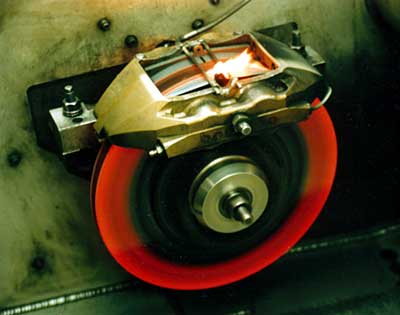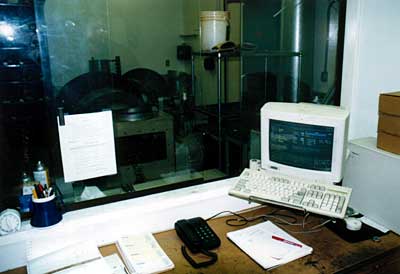INSIDE
RACING
T E C H N O L O G Y
IRT Home
IRT Home
News Page
Contents Page
Newsletter &
Books
email Paul
Pre-Bedding Brakes
The following article came out of a trip to Charlotte, No. Carolina in September '98. A similar article appeared in Racecar Engineering earlier in '99
Brakes on racecars have improved tremendously in the last few years. Race teams have taken advantage of new materials and processes but still have a way to go. Formula 1 teams have had problems because they've tried new brake materials without enough testing. A high coefficient of friction pad material doesn't help if the driver can't feel what's going on well enough to modulate braking force. I think that's what's causing the rash of brake problems and off-course excursions.
One of my informants tells me that braking distances are so short now in F1 that the drivers find it difficult to reduce pedal pressure as aero downforce bleeds off with car speed. I was told that some F1 drivers are loosening their safety belts, locking their leg on the brake pedal, and letting the falling deceleration of the car acting on their body mass reduce braking forces.
I'm not sure I understand that. Isn't it a chicken/egg problem?
Brake Pre-Bedding
by Paul Haney
Modern racecars need good brakes. Constant tire development and the aerodynamic downforce generated by racecars with wings and underwings allow decelerations of more than 3 Gs. While the car is slowing, aerodynamic forces decrease with the square of the speed causing tire grip to fall off, demanding that the driver modulate brake forces with extreme precision. 3,400-pound NASCAR stock cars racing on relatively small tire patches are equally demanding. Braking from 120 mph to 60 mph twice during a 20 second lap is typical for a stock car racing on a short oval track.
Equation Alert!!!
The Kinetic Energy of a body is equal to one half its mass times the square of its speed ( KE = MV2/2 ). Friction between brake pads and brake rotors slows a racecar converting its kinetic energy to heat.
Friction is defined by the equation Ff = CfF. The friction force caused by one body rubbing on another at a steady speed is the product of the coefficient of friction, a measured number, and the force pressing the two bodies together. Friction braking is a simple concept that becomes extremely complicated in reality.
Brake Bedding
One of those complications familiar to racers is "brake bedding." New disc-brake pads and rotors need to go through a specific process before they can be asked to perform reliably and efficiently under race conditions. Rotor and friction material manufacturers provide guidelines but most club racers and race teams seem to develop their own routines which generally means several laps on track alternating partial applications with cooling periods and then ending the process with a full-hard brake application followed by a gradual cooling. It's important that the racecar doesn't stop when pads and rotor are hot. This can result in uneven rotor cooling and deposition of pad material onto the rotor.
This bedding process accomplishes several tasks. It drives off volatiles from the pads that can otherwise lubricate the rotor/pad interface during hard braking causing the dreaded "green fade" that can send the driver and car spinning off into the weeds. Bedding also thermally relaxes the rotor, removes any burrs or machining oils from the rotor, and wipes a layer of pad material onto the rotor surface creating an almost mystical marriage between the rotor and the brake pads. Properly done this process insures good performance from the rotor and pads.
Bedding Eats Up Track Time
When racing was a more leisurely sport a team simply reserved track time during a test day or early on a race weekend for bedding brake sets and scuffing tires. As racing has become more competitive and more dependant on entertaining fans at the track and on television, track time has become more precious. For example, in the CART Fedex Championship a "time certain" rule went into effect for 1998. This rule states that all events must start and end as listed on the event schedule. There is no possibility for a team to regain track time lost because of the need to retrieve a car spun off course or to remove debris caused by a crash.
Pre-Bedding
As a result many teams are using pre-bedded brake pads and rotors. Pro-System, Inc. of Cornelius, No. Carolina performs this service. A visitor could easily miss Pro-System's building located a short distance away from Raceparts Distribution, Inc. (RDI), a source for racing parts for the NASCAR teams. Both buildings lie just across a railroad track from a rural two-lane road that used to be a main route south from Cornelius to Charlotte, now the center of the booming NASCAR industry. Charlotte is located about 200 miles inland from the Atlantic coast and half-way between New York City and Miami. More than a hundred race teams and multiples of that number of supporting businesses thrive in the Charlotte area.
Ashley Page runs Pro-System and is a co-owner of the business with RDI. Page raced karts in the 1960s, a Triumph Spitfire in Sports Car Club of America events during the 70s and worked with GTP teams in the 80s. "We bed pads and rotors for most of the NASCAR teams," Ashley said. "We probably supply 90% of the Winston Cup, Busch Grand National, and Craftsman Truck teams. CART is our next-biggest market and teams in other series do business with us also. We've had calls from a few European teams but don't do much with them yet."
"Our business is brake system testing and development
in high-performance applications," Ashley explained. "RDI
is the sales arm of the company and Pro-System does the R&D,
engineering, and manufacturing. RDI has 26 people, we have 6.
Our NC-controlled lathes and mills give us the capability to
manufacture precision, short-run parts. We help the race teams
with their brake hardware and brake ventilation."
People in the brake industry call brake pads friction material
and they refer to cooling as ventilation.
"NASCAR Winston Cup teams race at Martinsville Speedway, a half-mile, oval track with flat, tight-radius corners," Ashley explained. "Martinsville is very hard on brakes. Four years ago the cars didn't have enough pad material to last the race distance. It was common for a car to completely run out of brakes before the end of the race. Lap times have improve because of car development and better tires, and this has put an even higher demand on the brake system. We've worked hard with the teams to improve brake cooling and components, and we've made progress. Lap times at Martinsville are now less than 20 seconds, and pad wear isn't a problem. They mount an in-car camera under the car so the TV fans can see the brakes get hot and glow. It's an old track but they keep building bigger grandstands. More than a hundred thousand people go there on a race day. It's an exciting place to watch a race.
At intermediate tracks like the one at Rockingham the teams can run without brake ducting in the nose of the car and benefit from the lower aerodynamic drag. This is the result of improved cooling systems and better hardware from companies like Brembo whose products we sell to the NASCAR market."
Problems Remain
"The NASCAR teams still have brake problems and that's where we can help them"," Ashley told me. "We make a whole range of products: a pressure gage for setting brake bias on dual master cylinder systems, brake tools, pedal assemblies, brake hats for Brembo calipers, caliper mounts, mounting studs, a brake parts kit, and a rebuild service. They can bring us their calipers and we'll inspect them and rebuild them to factory specifications. We try to develop parts to make their lives easier.
"You'd think that all racecars would use dual master cylinders, but at least a third of the NASCAR teams still use the old Ford single-piston master cylinder. With 34 races in a season and very few weekends off they need to keep things simple, and some teams just haven't worked with a dual system long enough to get comfortable with it.
"Part of the problem is the pedal assembly is mounted behind the firewall under the dash, and it's hard to get to and difficult to maintain. We're working on a pedal assembly that will make it easier to adjust and maintain a dual system. Teams thrash to make the schedule, and I think more teams will switch to a dual system when it's not such a chore to service."
Pre-Bedding Process

The photos show the Pro-System brake dynamometer and the computer that controls the bedding runs and records the data. More than 90% of rotors and pads sold are pre-bedded. The type and size of rotor and pad determines the rotor speed, torque, and deceleration rate used in a bedding sequence. During a typical run the dynamometer spins up the rotor to the program speed. Hydraulic pressure is applied to the caliper to maintain constant torque against an inertia load that gives the best bedding result. At the end of the stop the process repeats until the pads or rotors are bedded.

The sequence of stops is designed to insure that the rotor is warmed slowly and reaches a temperature consistent with its final use on the racecar. The components are allowed to cool properly after the final cycle. A graph plotted by the computer shows torque, temperature, hydraulic pressure, and rotor speed. This graph and the summary data collected shows the operator and the customer that the run was successful.
"We've done development work for caliper manufacturers and for friction material manufacturers," Ashley said. "We've tested rotors made from unique materials like aluminum and titanium. Those customers wanted to know the critical temperatures, pad wear, torque, and forces.
"Pro-System's brake business is growing. We'll develop a series of tests to suit customer needs. We can use track data furnished by the customer to develop track simulation tests. This gives the customer information needed for further development. When the product goes to the track it's in a more finished form and makes the track testing more efficient. A second dyno is under construction because of increasing demand from our customers."
Racing is an expensive sport. Track time is precious and racing teams would rather spend that time carrying out their test program, accumulating data, and working with their driver. If they can install pre-bedded rotors and pads they save some of that precious time on track.
If you have questions, contact:
Ashley Page
Pro-System
19510 Zion Street
PO Box 1595
Cornelius, NC 28031, USA
Voice: 704-892-8688
Fax: 704-896-5886
Email: ampage@mindspring.com